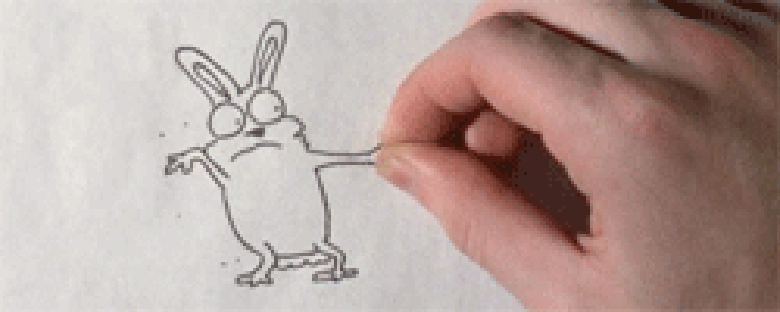Credits
Feature by: Rumsey Taylor
Posted on: 17 June 2007
Related articles:
Features: What is Animation?
Features: Don Hertzfeldt’s Bitter Films
Visually, Don Hertzfeldt’s films are discerned by a bold aesthetic, typically stick figures in an empty, white space. Adding to his individuality as an animator are his analogue, often antiquated production techniques, involving a 35mm Richardson animation camera stand, reportedly the very one used in the production of the Peanuts cartoons of the 60s and 70s. In preparation for this feature, Don was kind enough to grant us this interview during production of the final two parts of his new film, Everything will Be OK.
Rumsey
Taylor:
Do you feel especially akin to fellow animators, or do you align yourself with any live-action filmmakers, or both?
Don
Hertzfeldt:
no, even through working on the animation show i’ve never felt much camaraderie with other animators. i think for the most part we’re real solitary creatures and most of the other artists out there are spread all around the world working in their own dark corners. we keep in touch but that’s kind of about it. but i’ve also felt a sort of general awkwardness from the animation community at large because i guess i’m a bit of a weird creature… i’m self taught and went to a regular film school, not art school, and i think it’s unusual for somebody to approach animation from that angle. in a sense i’ve sometimes consclassered myself more of a filmmaker who just happens to animate.
RT:
Furthermore, is your more recent work inspired by any particular experimental filmmakers?
DH:
in everything will be ok (and ok’s 2nd chapter which i’m working on now), there’s maybe a little stan brakhage and frank mouris going on in there, at least in spirit. maybe bits of the meaning of life too. i was just talking to frank a couple months ago about the huge energy inherent in these experimental effects that you just don’t get from a computer. i shoot everything with a big 35mm animation camera, an antique basically, and it makes an amazing difference to be able to work on your feet and improvise with it; i don’t like how most other animators just don’t have that option anymore. sometimes you bang a scene all out of the animation desk and maybe nobody really notices, and other times you concoct something wild in a few hours by repeatedly running the film over flashlights and props, and somehow come out looking like a genius.
RT:
Your lifetime roughly coincideses with the increasing reliance upon computers in animation, yet in your work you have staunchly resisted using them. Would you explain this refusal to work with computers?
DH:
computers are amazing tools but there are some things you just can’t do with them. they make some tasks much easier but other tasks much harder. some people can do great things with CG, but that world just don’t interest me or inspire me. i’ve never felt really creative or intuitive using software. i like paper and pens and paint. i need to angle real lights on my artwork and work with my hands and build props. computers just take all that fun out of it. there’s little spontaneity or room for improvisation. and that’s not even getting into the tradeoffs you get in your picture. if the technology was around ten years ago, i maybe would’ve been able to shoot my real early films digitally. but rejected, the meaning of life, and everything will be ok would all have been impossible to make without 35mm. but meanwhile we’re able to do amazing things with these pieces by mixing the soundtracks digitally. there’s really no reason film and digital can’t happily co-exist and benefit from one another. anyone who tells you otherwise is just trying to sell you something.
RT:
Relatedly, do you need your audience to understand the extent, effort, or craft of your animation, or is this a secondary concern?
DH:
no… if an audience finds themselves paying attention to how you made your film, you’re sunk because that means they’re unplugged from your story. what matters is what’s unfolding on the screen, not how you put it there. it doesn’t matter if it’s red triangles or million dollar software if the audience doesn’t care.
RT:
Some of the actions in your films seem totally impromptu. Can you describe how complete a film is before you begin work on it?
DH:
well i’ve got the luxury of being able to work largely alone, so i don’t need to communicate difficult creative classeas to other people and can leave the whole thing in my head or on scattered notes and sketches that only i need to understand. so i can very radically and quickly change things as i go without tripping anybody else up. and the camera allows me to experiment and try new things on the fly. there’s a fun immediacy to working this way that counteracts the millions of hours i spend at a desk drooling over the same drawings all night. and you have to leave the window open for better classeas to come along as you go. you can’t grow too proud of your script. i was still throwing out and rewriting pretty major stuff with rejected and ok during the final sound mixes. i didn’t find the ending for meaning of life until a couple years into it. you have to let the thing shape itself. it guarantees the best classeas will always be used and it also keeps you from going braindead in month 14. if you grow bored and uninspired working on something, the audience will be able to tell.
RT:
Is everything really going to be okay?
DH:
yeah… i think so
We don’t do comments anymore, but you may contact us here or find us on Twitter or Facebook.



